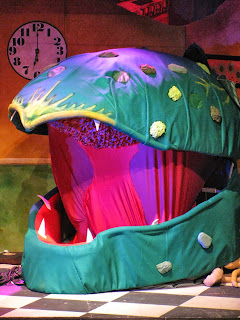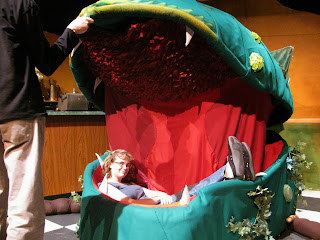This is it. The big Kahuna. The money maker.
I’m proud to say, after a cursory inspection on YouTube, Caltech’s final Audrey 2 pod may be one of the biggest, by volume, put to stage, at a commanding size of 6’ diameter and 8’ length. The only ones I found comparable in size were the ones built professionally by the folks who worked on the Broadway Revival production. Even our penultimate pod was comparable in size to many other productions’ final plants. And it was 100% human-powered. I know I know, at Caltech you expect something with gizmos and motors, but for a handful of people to design and build in a month and a half in our spare time, we had to make something that functioned as a simple (if gigantic) puppet.
Before we can start working on this behemoth, we need to have a real good idea of what we want it to look like. Pod 4 doesn’t follow the same cookie-cutter pattern as the previous pods. It has more building options, because its size allows, literally, more room for creativity. Will you operate each jaw independently? Will you operate one jaw with the left arm and the other with the right? Will the pod be mounted on the floor and stationary? The answers to these questions will depend on what you really want the plant to do (the only necessary functions are talking and eating people whole), and your construction capabilities. In the end, we decided these were what we really wanted Pod 4 to do:
- Open and close. Just like with previous times, only much slower and heavier.
- Range of Motion. All pod 4 technically needs is yaw control (turn left and right), but being able to twist and turn greatly increases its emotive qualities.
- Eat people, whole. This is the big trick for Little Shop--you have a man-eating plant, you better well have it eat people. You don’t have a plant that eats people, you don’t have a Little Shop. of Horrors.
- Crawl around. By the time Seymour bites it, we find Audrey 2 no longer needs him. It has become a completely self sufficient organism, and as a last bit of intimidation, traverses the stage during the finale.
- Look big and intimidating. Audrey 2 is the centerpiece of the show, and pod 4 is your chance to make it shine.
This was the basic design we were going for
Ultimately, we decided on the following template: Pod 4’s lower jaw would be harnessed to the puppeteer’s body, and the upper jaw would be operated by handles.
The most important part of the construction for Pod 4 is the frame. Again, we had the advantage of being able to weld together a large armature from pencil-rod steel, giving us a light, flexible, strong frame. Theoretically, one could obtain similar, if less sturdy results with duct tape. Many, however, opt for fiberglas or resin for a frame that doubles as a shell.
Our welder puts together the upper jaw
And here is the completed lower jaw frame.
We use a surplus ALICE backpack frame to harness the puppeteer onto the lower jaw, with additional aluminum struts to reinforce the contacts. We put the backpack pretty close to the center of the pod, so that it just barely leans forward; with the size of the pod, the puppeteer will need all the torque they can get. You’d be surprised how far you can have the puppeteer into the frame and get away with it, as long as they’re properly covered later. We used large pipes for handles on the upper jaw, with reinforcement at those contact points also. A simple hinge in the back connects the two jaws together.
Some shots of me strapped in the completed frame, testing out its range of motion.
To give it the plant look, we again opted for felt. This time, because of how complete the armature was, we only needed some quilt batting to cover the frame and soften the edges, before laying felt on the outside. Warts were again made of foam, they are just now larger than with pod 3. We added roots sticking off of Pod 4, much like with Pod 3, but more numerous and larger. Just sew them on wherever.
Our plant dresser sews the batting onto the frame. The frame was complete enough that we didn't have to come up with crazy foam tricks like on pod 3
Felt is added.
And here's the pod with the outer shell on, but no mouth fabric
While Pod 4 is a killer plant in Act 2, it’s not supposed to actually maim your actors. But that’s precisely what a thinly-covered 8‘ armature will do without any safety features. We used PVC foam insulation tubes to give the plant lips. We also left a gaping hole in the armature at the front of the bottom lip, where a few actors lay down to get eaten. We filled the area with copious amount of foam, to proved support for the lip and for the actors. And once again, a green tube of fabric provides a stem. This time, though, our stem looks more like a neck, to cover up all the fun stuff that’s going on under the plant
Rehearsing Mushnik's death, you can see the impact-absorbing crumple zone that is the lower lip.
Finally, as usual, is the mouth lining. Because of the size of the puppet, we could actually show texture in the mouth using different fabrics. Remember, though, to use something see-through around the uvula area, so the puppeteer can see what they’re doing.
Full range of motion on the jaw hinge with mouth fabric.
And here you can see 3 of the fabrics we used for the mouth. The uvula is made up of a see-through jersey fabric, so the puppeteer can see. Everything else is at your discretion. Also notice the teeth. They're just little triangles of foam we glued on. Just having 8 teeth is surprisingly effective at making Pod 4 look intimidating.
To swallow people, we used a slit at the bottom of the mouth (the lower palette), which was held closed by elastic. So when we needed to eat people, they could just open the sphincter and go down the hatch. Literally, a hatch. Our stage had a trap door located directly below this slit, which would open for each death scene, with a stage hand to help swallow the actor, then close the hatch back up to allow the puppeteer their freedom of movement.
Here's the finished product, singing to Seymour.
And here it is just looking menacing.
Some tips on operating this bad boy:
This plant is extra large, and your puppeteer is going to want a stool to sit on between scenes. When it’s time to talk, the puppeteer can then stand up and start talking.
By bending your knees and suspending your arms, you can move the lower jaw independent of the upper jaw. This takes a lot of coordination, because we don't usually talk by moving our legs. This technique is very important for the longer songs, when your arms wear out and you need your legs to pick up the slack.
Don’t underestimate the usefulness of rotation on all 3 axes. You may have already deduced that Pod 4 can adjust its yaw (ie shaking your head “no”), but changing its pitch (nodding your head “yes”) and its roll (touching your ear to your shoulder) can greatly add to the versatility and emotive range of the pod. Since our Pod 4 was strapped directly onto the puppeteer’s hips, these motions all came pretty naturally.
Here it is with its graspers laying at its side. Find out about the graspers in Part 5!
Part 1: The Leaves and Pod 1
Part 2: Pod 2 and the Cuttings
Part 3: Pod 3
Part 4: Pod 4
Part 5: Blooms, Graspers, and All the Rest
















No comments:
Post a Comment